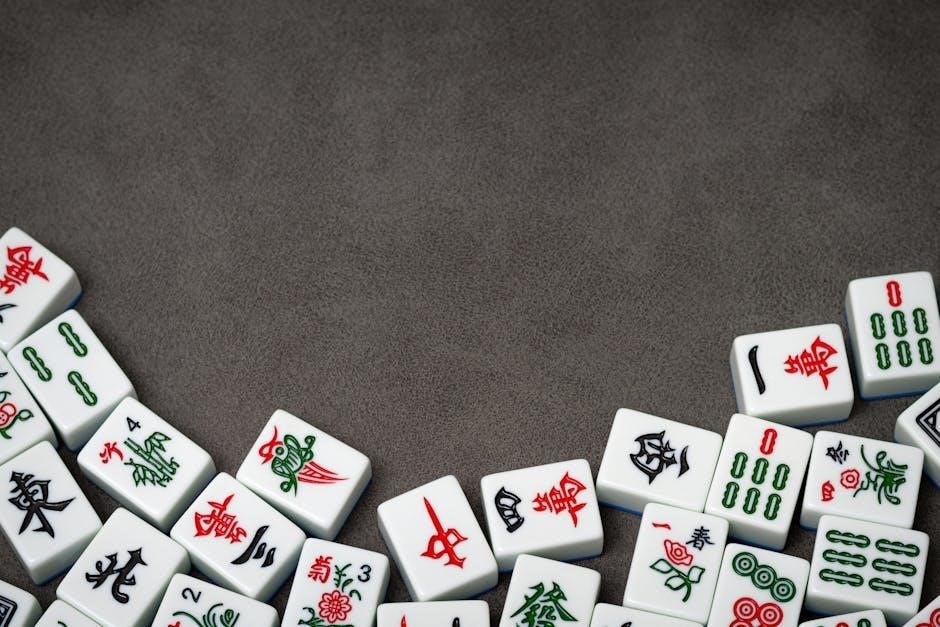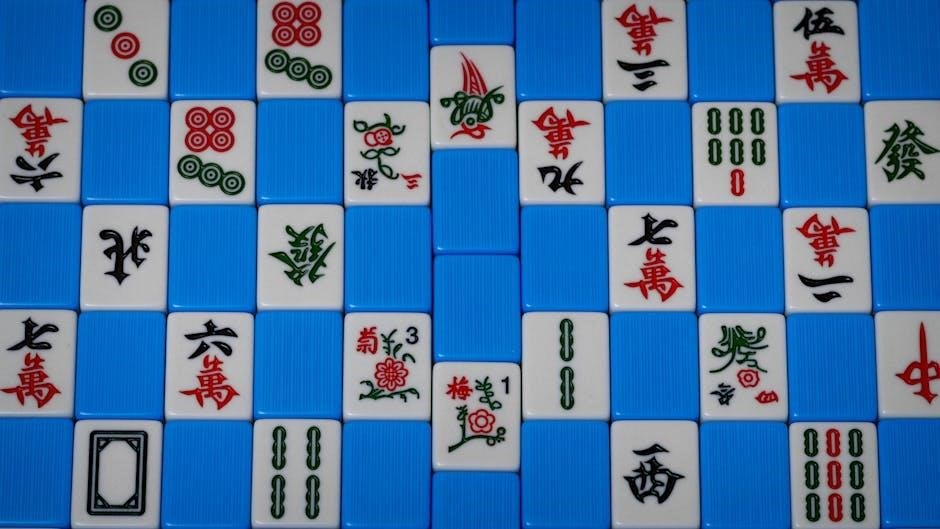Chinese Mahjong Rules PDF: A Comprehensive Guide
Mahjong, a game of skill from China, now has accessible guides! This PDF offers detailed Chinese Mahjong rules, covering essential aspects. Learn the objectives, gameplay, and scoring nuances. Understand melds, hand formations, and various rule variations. Download the guide to master this engaging game!
Chinese Mahjong, a captivating four-player game originating in China, combines skill, strategy, and a touch of chance. Similar to Western Gin Rummy in concept, Mahjong involves forming complete hands with tiles instead of cards. While variations exist, the Chinese version emphasizes specific rules and tile sets.
This guide focuses on Chinese Mahjong, also known as Official International Rules, recognized by the State Sports Commission of China in 1998. It offers a comprehensive understanding of the game’s core elements, enabling players to grasp its intricacies and nuances. From tile arrangements to scoring methodologies, this introduction paves the way for a deeper exploration of Mahjong‘s strategic depth. Delve into the world of Chinese Mahjong and discover a game rich in history and intellectual stimulation.
Whether you’re a novice or an experienced player, this introduction sets the stage for mastering the art of Chinese Mahjong. Prepare to embark on a journey of strategic thinking, tile manipulation, and the pursuit of the ultimate winning hand, all within the framework of this enthralling Chinese pastime.
Tile Set and Components

Chinese Mahjong utilizes a set of 144 tiles adorned with Chinese characters and symbols; however, regional variations might exclude tiles or introduce unique additions. Generally, players start with 13 tiles each.
The tile set encompasses three suits: Bamboos, Circles, and Characters. Each suit contains tiles numbered 1 through 9. Additionally, there are Honor tiles, comprising Dragons (Red, Green, and White) and Winds (East, South, West, and North). Some sets include Flower and Season tiles, adding further complexity.
Understanding the tile set is crucial for gameplay. Players must recognize the suits, numbers, and honor tiles to form valid melds and complete winning hands. Familiarity with the tiles allows for strategic decision-making when drawing, discarding, and claiming tiles from other players.
Furthermore, the components extend beyond the tiles themselves. Dice are used to determine the starting player and tile-breaking point. Racks help organize each player’s hand, and counters facilitate scorekeeping; Mastering the tile set and components forms the foundation for successful Mahjong play.
Objective of the Game
The primary objective in Chinese Mahjong is to form a complete hand consisting of four melds (sets) and a pair, totaling 14 tiles. A meld can be a Pung (three identical tiles), a Chow (a sequence of three tiles in the same suit), or a Kong (four identical tiles).
Players take turns drawing and discarding tiles, strategically building their hand towards completion. The goal is to be the first player to declare “Mahjong” by acquiring the 14th tile needed to complete a legal hand.
Winning involves careful planning, observation of opponents’ discards, and skillful tile management. Players must assess the probability of drawing needed tiles, while also preventing opponents from completing their hands. Strategic discarding is crucial, as it can influence the availability of tiles for other players.
Moreover, the objective extends beyond simply completing a hand. Players aim to create hands with higher point values to maximize their score. Understanding the scoring system and the value of different melds is essential for achieving a competitive edge. Ultimately, the goal is to outmaneuver opponents and emerge as the victor by declaring “Mahjong” with a high-scoring hand.
Basic Gameplay: Drawing and Discarding
The basic gameplay of Chinese Mahjong revolves around the cyclical actions of drawing and discarding tiles. Each player, in turn, draws a tile from the wall and subsequently discards one from their hand. This process continues until a player declares “Mahjong” by completing a legal hand.
At the start of each turn, a player draws a tile, adding it to their existing hand of 13 tiles. After examining the drawn tile, the player must then choose one tile to discard. The discarded tile is placed face-up in the center of the playing area, making it available for other players to claim if they can use it to form a meld.
Strategic discarding is crucial. Players must carefully consider which tiles to discard, balancing the need to improve their own hand with the risk of helping opponents. Discarding a tile that an opponent needs to complete a meld can significantly hinder their progress. Skillful players can deduce which tiles their opponents are collecting and avoid discarding them.
The drawing and discarding cycle continues until a player successfully completes their hand, declaring “Mahjong” and winning the round. Understanding the nuances of this basic gameplay is fundamental to mastering Chinese Mahjong.
Melds: Pung, Chow, and Kong
In Chinese Mahjong, forming melds is crucial for constructing a winning hand. The three primary types of melds are the Pung, Chow, and Kong, each with its own unique characteristics and requirements.
A Pung consists of three identical tiles. A player can declare a Pung when another player discards a tile that matches two tiles already in their hand. By calling “Pung,” the player claims the discarded tile and exposes the three identical tiles face-up on the table.
A Chow is a sequence of three consecutive tiles of the same suit. However, a Chow can only be declared using a tile discarded by the player to your immediate left. Calling “Chow” allows you to claim the discarded tile and display the sequential set face-up.
A Kong is a set of four identical tiles. A Kong can be declared in three ways: by drawing the fourth matching tile yourself, by claiming a discarded tile to complete a Kong, or by upgrading an existing Pung when you draw the fourth matching tile. Declaring a Kong typically awards extra points in scoring.
Mastering the formation and strategic use of Pung, Chow, and Kong is essential for success in Chinese Mahjong.
Winning Hand Formation
The ultimate goal in Chinese Mahjong is to form a complete winning hand. A standard winning hand consists of four melds (sets) and a pair (two identical tiles). These melds can be any combination of Pung (three identical tiles), Chow (a sequence of three tiles in the same suit), or Kong (four identical tiles).
A player wins by drawing the 14th tile needed to complete their hand. This tile can either be drawn from the wall or claimed from another player’s discard, depending on the specific hand being formed. Certain special hands may have different requirements or tile combinations to achieve a win.

It is crucial to strategize and plan your hand carefully, considering the tiles you have and the discards made by other players. Balancing the formation of melds with the need to conceal valuable tiles can be key to preventing opponents from intercepting your winning tile.
Understanding the various winning hand patterns and their associated point values is essential for maximizing your score and achieving victory in Chinese Mahjong. Mastering the art of hand formation requires practice, observation, and a keen understanding of the game’s dynamics.
Scoring System in Chinese Mahjong
Chinese Mahjong employs a multifaceted scoring system that rewards players for various hand formations and achievements during gameplay. The scoring is based on the type of winning hand, the presence of specific tile combinations, and any bonus points earned through particular plays.
Each winning hand has a base point value that can be increased by factors such as concealed sets, special tile combinations, or self-drawn tiles. The complexity of the hand and the rarity of the tiles used contribute to a higher score. Players can also earn bonus points for declaring a Kong or for winning with a tile discarded by another player.
Understanding the scoring system is crucial for strategic play. Players must carefully consider the potential point value of different hand formations when deciding which tiles to keep or discard. Balancing the pursuit of high-scoring hands with the need to complete a hand quickly requires skill and experience.
Different variations of Chinese Mahjong may have slight alterations to the scoring system, so it is essential to familiarize yourself with the specific rules being used. Mastering the scoring system allows players to maximize their points and increase their chances of winning.
Common Rule Variations

Chinese Mahjong, deeply rooted in tradition, exhibits a fascinating array of regional and house rule variations that contribute to its diverse character. These variations often involve differences in scoring, tile usage, and gameplay mechanics, reflecting the unique preferences of different communities and playing groups.
One common variation lies in the inclusion or exclusion of certain tiles. Some versions omit flower and season tiles, while others introduce unique tiles with special functions. These variations impact hand formations and scoring possibilities, altering the strategic landscape of the game.
Scoring systems also differ across variations. Some versions emphasize intricate point calculations based on numerous tile combinations, while others simplify the scoring process. Minimum point requirements for winning may also vary, influencing players’ decisions on when to declare Mahjong.
Gameplay mechanics can also differ. For example, some variations allow players to steal discards to complete any meld, while others restrict stealing to specific meld types. These variations affect the pace and dynamics of the game, requiring players to adapt their strategies accordingly.
Exploring these common rule variations adds depth and richness to the Chinese Mahjong experience, offering players a chance to discover new challenges and strategic possibilities.
Official International Rules (MCR)
The Official International Rules (MCR), also known as Chinese Official Mahjong, represent a standardized rule set designed to promote fair play and international competitions. Developed in China, MCR aims to unify the diverse regional variations of Mahjong under a comprehensive and consistent framework.
MCR specifies a standard tile set, including the three suits, honor tiles, and optional flower and season tiles. The rules define valid melds, hand formations, and scoring methods, ensuring a level playing field for players from different backgrounds.
The scoring system in MCR is intricate, with points awarded for various tile combinations, concealed sets, and special hands. The rules also outline doubles that can multiply the score, adding complexity to the scoring process.
MCR emphasizes skill and strategy, encouraging players to demonstrate their expertise in tile management, hand building, and defensive play. The rules also promote ethical conduct and sportsmanship, fostering a positive and competitive environment.
MCR has gained recognition as the official rule set for international Mahjong tournaments and competitions, attracting players from around the world. Its comprehensive nature and emphasis on fairness make it a popular choice for those seeking a standardized and challenging Mahjong experience. Resources, including PDF documents, are available for learning these rules.
Resources for Learning and Playing

Embarking on the journey of mastering Chinese Mahjong requires access to reliable learning materials and platforms for practice. Fortunately, a plethora of resources cater to both beginners and seasoned players seeking to refine their skills.
Numerous websites offer comprehensive tutorials, rule explanations, and strategic insights into Chinese Mahjong. These online platforms often provide interactive simulations, allowing players to practice hand building, tile management, and scoring techniques.
For those who prefer a tangible learning experience, a variety of books and PDF guides delve into the intricacies of Chinese Mahjong. These resources typically cover the rules, scoring systems, hand formations, and advanced strategies in detail.
Online communities and forums dedicated to Mahjong enthusiasts provide a valuable platform for connecting with fellow players, exchanging tips, and seeking guidance from experienced individuals. These communities often host online tournaments and events, offering opportunities to test your skills against others.
Several mobile apps and software programs offer virtual Mahjong games, allowing you to practice anytime, anywhere. These digital platforms often feature customizable rule sets, difficulty levels, and AI opponents to simulate real-life gameplay. These resources will help you learn and play effectively.

